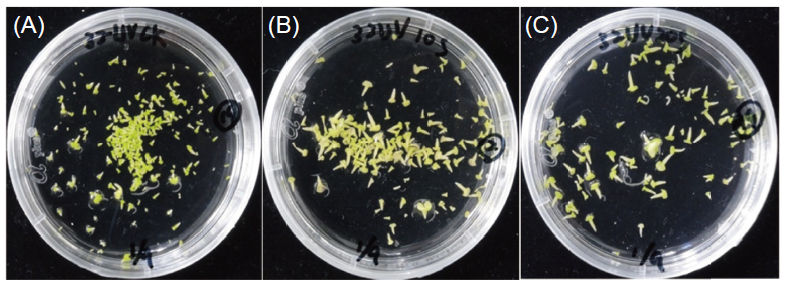All issues

Author:Chi-Ni Hsia, Uei-Chern Chen, Shiow-Huey Hseu, Chen-Yu Lin, Chin-Yi Tsao, and Tzu-Kai Lin*
Abstract:
An integrated haploid mutagenesis platform through doubled haploid (DH) donor plants providing microspores in cauliflowers was established in this study. Ultraviolet (UV) irradiation was applied to microspores of four DH lines derived from ‘Chinglong S-65’ and each line with various heading mature days. Embryos derived from UV treated microspores of DH32 as stated above were treated with ethyl methanesulphonate (EMS) subsequently for double mutagenesis. EMS was also applied on flower buds of ‘Chinglong S-65’ before microspore culturing for mutagenesis. The results showed that embryo production (embryos/petri dish) from two UV exposure duration in all four DH lines was significantly lower, accounting for 23.9% to 65.1% decrease compared to the control. However, no significant difference was observed on embryo production between the two UV exposure duration. The results also showed that embryo germination rate of the UV treated microspores decreasing 50.9 to 78.8% compared to that of the control. Cotyledonary embryos of DH32 derived from the UV 10 s treatment were soaked in 0.125–0.5% ethyl methanesulphonate (EMS) for 10 min. Embryo germination rates decreased in all EMS treatments by 36.4% to 56.8% compared to that of the control. However, no significant difference was found among tree EMS treatments. Flower buds of ‘Chinglong S-65’ were soaked in 0.025–0.1% EMS for 5 or 10 min with or without shaking for mutagenesis before microspore culturing. The results showed that regardless exposure time, the highest embryo production was obtained in buds treated with 0.025% EMS. However, embryo production decreased as exposure time increased and shaking was applied. DH plants derived from the UV or double mutagenesis (UV plus EMS) of four of DH lines were cultivated in the field and data were recorded at 84 d after cultivation. Field observation concluded that percentage of early growth rate was higher than that of delaying based on developmental performance of DH mutants in the four DH lines. Our results not only provide useful information for prediction of mutant tendency in cauliflower but also demonstrate that haploid mutagenesis is capable of shortening time span and enhancing selection efficiency on breeding. Additionally, this study demonstrated that trait screening on mutants was more efficient than using the highly uniform DH as donor plants for haploid mutagenesis.
Key words:Brassica oleracea var. botrytis L., Microspore culture, Doubled haploid, Haploid mutagenesis
Download:![]() PDF Links
PDF Links
- 1. Development of Tractor-Mounted Seedling Transplanter for Sweet Potato
- 2. Synergistic Effect of Additional Gas on the Toxicity of Phosphine to Sitophilus oryzae and Sitophilus zeamais (Coleoptera: Dryophthoridae)
- 3. Effects of Temperature and Solar Radiation on Growth Traits and Plant Elements in Purple Leafy Sweet Potato
 Submit your manuscript
Submit your manuscript
 Guide for authors
Guide for authors